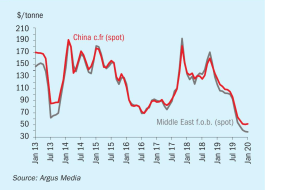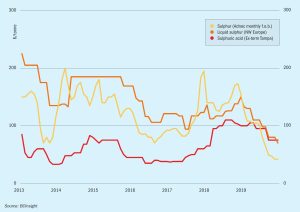
Market Insight
Market Insight courtesy of Argus Media

Market Insight courtesy of Argus Media

Rice is one of the world’s most popular food staples, providing around one-fifth of the total global calorific value of human diets. Cultivation and consumption is particularly prevalent in Asian countries. We look at the nutrient needs of this widely-grown cereal.

Canadian Press reports in December have highlighted concerns that the new tighter IMO rules on sulphur content of marine fuels, which came into force on January 1st, could lead to reduced demand for oil sands bitumen and syncrude. Canadian oil output has been steadily increasing over the past two decades, mainly due to expanded bitumen recovery, which now accounts for 50% of Canada’s 4.6 million bbl/d of oil production. However, the discount for Western Canadian Select bitumen blend crude prices versus North American benchmark West Texas Intermediate could almost double to $30/bbl in January, according to consultancy Wood Mackenzie, averaging US$23-24/bbl for most of 2020, as US and other refiners use less heavy, sour oil and switch to lower sulphur feeds to try and optimise low sulphur fuel oil (LSFO) production. However, reduced output from Canada’s competitors Mexico and Venezuela is currently helping to mitigate this. Oil sands producers with refineries or upgraders are expected to benefit as the new standards will increase demand for refined low-sulphur fuels. For example, Husky Energy has expanded its Lloydminster Upgrader to produce an extra 4,000 bbl/d of diesel, and reconfigured its Lima refinery in Ohio to use more heavy oil.

A New Year is typically a time for taking stock, for looking back at the year just gone, and thinking about the year to come. This year of course marks a bigger transition, from the 2010s to the 2020s. The past decade has been a volatile one, existing under the shadow of the global financial crisis of 2008-09, from which the world was still just emerging in 2010. Over the past decade, ‘quantitative easing’ has helped prevent deflation and driven a decade long stock market rally, but also kept both public and private debt levels high, as interest rates stay low. Weaning the global economy off QE has proved to be far more difficult than many anticipated.

The Sixth Annual MESPON Forum took place 7-10 October at the Rosewood Hotel Abu Dhabi, where the global sour gas and sulphur community gathered for four days of networking, learning, and collaboration. This year’s theme highlighted new trends, innovations and best practices in the field of sour gas processing that enhance operations.

CRU’s Sulphur + Sulphuric Acid 2019 conference was held in Houston last November.

Meena Chauhan , Head of Sulphur and Sulphuric Acid Research, Argus Media, assesses price trends and the market outlook for sulphur.

After a poor 2019, when global demand contracted by nearly 2.5%, phosphate markets are expected to rebound in 2020. Saudi Arabia and Morocco dominate new capacity additions while India and Brazil continue to be the key importers. US and Chinese production is in slow decline, meanwhile.

How the processed phosphates market develops over the coming months will be a major factor for the short term outlook for sulphur trends. Improvement is anticipated in the phosphates market from around mid-2020 which may help to support sulphur demand and in turn pricing.

Sulphuric acid plant operators juggle multiple issues trying to keep their plants running efficiently and reliably. With the revolutionary ClearView™ process health monitoring solution, as well the DynSOx™ software for simulating dynamic operation, Haldor Topsoe strives to bring digital services with real and tangible operational benefits to the sulphuric acid industry. P. Szafran and M. Granroth discuss how together these digital services can help acid plant operators meet their daily targets.